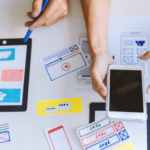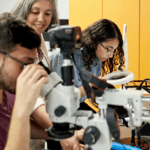In any educational or training environment, the fusion of traditional and digital learning methods creates transformative experiences for learners and educators alike. Blended learning models, which integrate face-to-face classroom instruction with online digital resources, offer a harmonious balance that harnesses the strengths of both paradigms. This synergy provides a flexible, personalised, and enriched learning environment that caters to diverse learning styles, paces, and preferences. As technology advances, blended learning becomes indispensable to effective education and training programmes.
Benefits of Blended Learning
Blended learning models revolutionise the educational landscape by combining traditional classroom methods with modern digital tools. This integrated approach offers a range of benefits that are difficult to achieve through a single method. By employing physical and virtual environments, blended learning enhances flexibility, accessibility, engagement, personalisation, and cost-effectiveness. It allows for a more inclusive and interactive educational experience tailored to meet the diverse needs of learners while optimising resources and reducing costs.
Flexibility and Accessibility
- Anytime, Anywhere Learning: Digital platforms allow learners to access content conveniently, breaking the constraints of fixed classroom schedules.
- Inclusivity: Online resources can be tailored to support learners with different needs, ensuring education is accessible to all.
Enhanced Engagement and Interaction
- Interactive Content: Digital tools incorporate multimedia elements such as videos, quizzes, and simulations, creating a more engaging learning experience.
- Collaborative Tools: Online forums, discussion boards, and shared documents make it easier for learners to collaborate and engage with peers and instructors, enhancing interaction beyond the classroom.
Personalised Learning Experiences
- Adaptive Learning Technologies: These technologies adjust content according to the learner’s proficiency, providing customised pathways that suit individual learning needs.
- Progress Tracking: Detailed analytics and reporting tools help learners and educators monitor progress and identify areas for improvement.
Cost-Effectiveness and Resource Efficiency
- Reduced Infrastructure Costs: Digital learning diminishes the need for physical space and materials, making education more cost-effective.
- Scalable Solutions: Once created, digital content can be reused and scaled to accommodate large numbers of learners without significant additional costs.
Implementing Blended Learning Models
Transitioning to a blended learning approach requires meticulous planning and integrating digital and traditional teaching methods seamlessly. Implementing blended learning involves aligning curriculum design with learning objectives, establishing a robust technological infrastructure, training educators, and preparing students for a new learning paradigm. By strategically combining these elements, institutions can create a dynamic and effective educational environment that maximises the benefits of both in-person and online learning experiences.
Curriculum Design
- Integrated Learning Objectives: Ensure digital and face-to-face components align with overarching learning outcomes.
- Balanced Content Delivery: A well-designed curriculum finds an optimal mix between in-class activities and online modules, preventing over-reliance on one format.
Technological Infrastructure
- Reliable Digital Platforms: Choose robust Learning Management Systems (LMS) that support content delivery, interaction, and assessments.
- Support Services: Provide technical support and training for educators and learners to maximise the effective use of digital tools.
Instructor Training and Development
- Professional Development Programmes: Equip educators with the skills to design and deliver effective blended learning experiences.
- Ongoing Support: Establish continuous training and support to help instructors stay updated with new technologies and pedagogical strategies.
Student Preparedness
- Orientation Programmes: Prepare students with the technical skills and self-regulatory capabilities needed for successful engagement in blended learning environments.
- Feedback Mechanisms: Implement regular feedback loops to ensure that the learning model meets student needs and facilitates continuous improvement.
Challenges and Solutions in Blended Learning
Blended learning brings numerous advantages, but its implementation also comes with significant challenges that must be addressed to ensure success. These challenges include the digital divide, resistance to change, and maintaining quality assurance. Addressing these issues requires strategic solutions, such as providing flexible access to resources, generating a culture of openness, and establishing rigorous quality standards. By proactively tackling these challenges, educational institutions can create a more effective and inclusive blended learning environment.
Digital Divide
- Issue: Not all learners have equal access to technology and reliable internet connections.
- Solution: Provide offline resources and flexible access options, and work with community organisations to improve connectivity.
Resistance to Change
- Issue: Both educators and learners may resist adopting new technologies and methodologies.
- Solution: Create a culture of openness and provide ample training and support to ease the transition.
Quality Assurance
- Issue: Ensuring the consistent quality of digital content and instructional methods can be challenging.
- Solution: Establish rigorous quality standards and regularly review and update digital materials and teaching strategies.
Conclusion
Blending traditional and digital learning methods is not simply a matter of integrating technology into the classroom; it’s about creating a dynamic and engaging learning environment that uses the best of both worlds. By thoughtfully combining face-to-face instruction with digital resources, educators can provide richer, more personalised learning experiences that meet the diverse needs of today’s learners. As technology continues to evolve, the potential for blended learning will only grow, offering endless possibilities for enhancing educational outcomes. The key to success lies in strategic planning, continuous support, and a commitment to quality and inclusivity.



